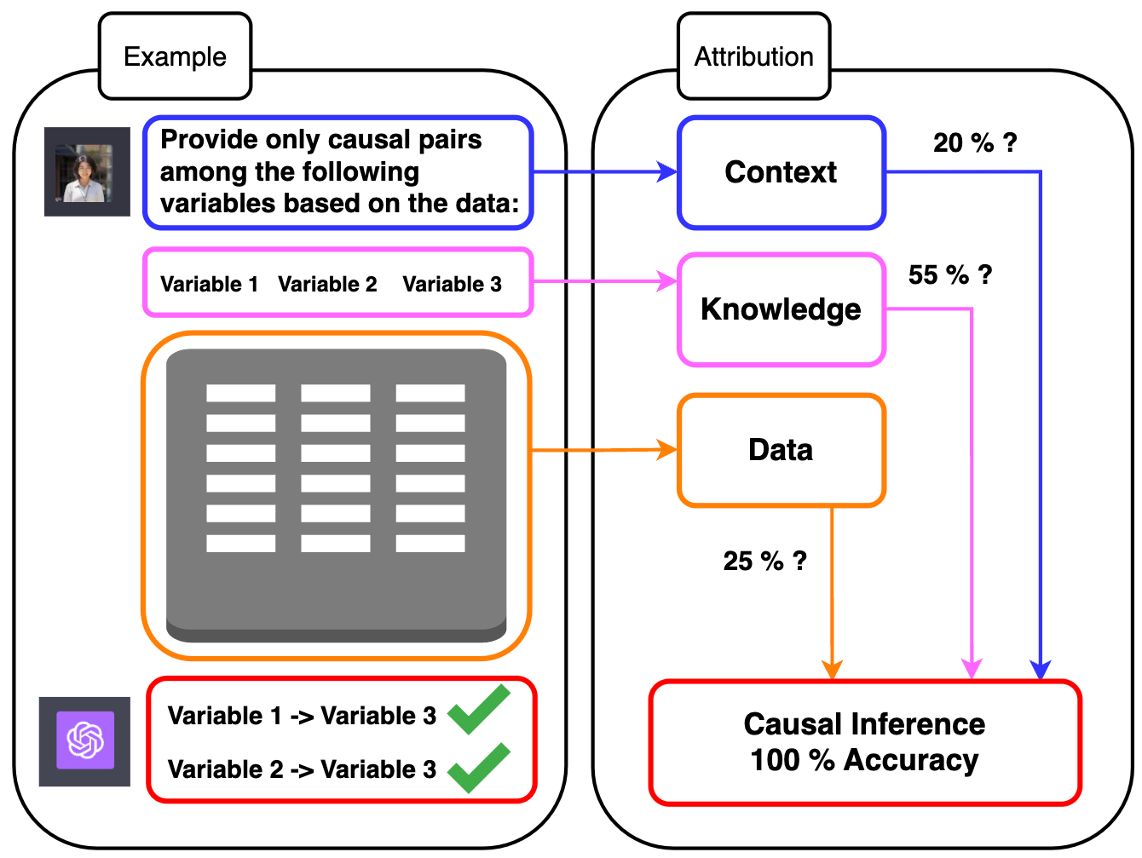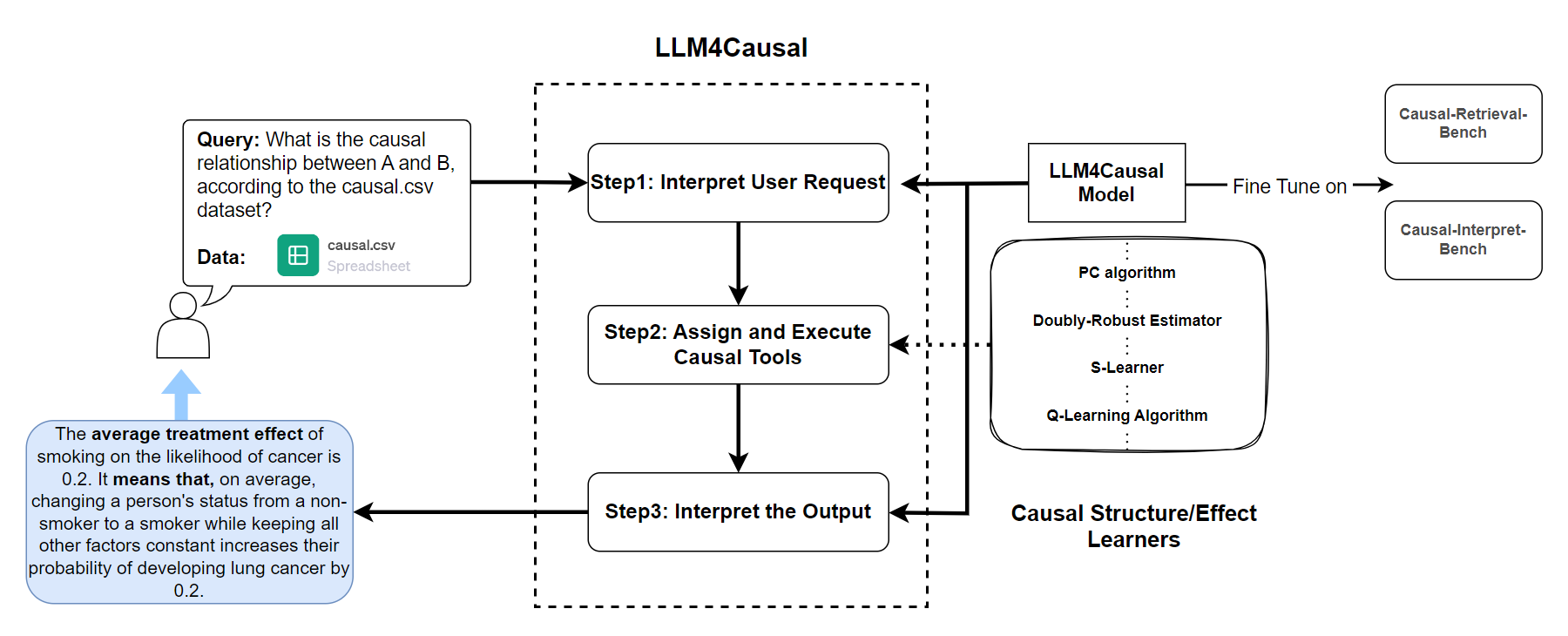Large Language Models for Constrained-Based Causal Discovery
2406.07378

0
0

Abstract
Causality is essential for understanding complex systems, such as the economy, the brain, and the climate. Constructing causal graphs often relies on either data-driven or expert-driven approaches, both fraught with challenges. The former methods, like the celebrated PC algorithm, face issues with data requirements and assumptions of causal sufficiency, while the latter demand substantial time and domain knowledge. This work explores the capabilities of Large Language Models (LLMs) as an alternative to domain experts for causal graph generation. We frame conditional independence queries as prompts to LLMs and employ the PC algorithm with the answers. The performance of the LLM-based conditional independence oracle on systems with known causal graphs shows a high degree of variability. We improve the performance through a proposed statistical-inspired voting schema that allows some control over false-positive and false-negative rates. Inspecting the chain-of-thought argumentation, we find causal reasoning to justify its answer to a probabilistic query. We show evidence that knowledge-based CIT could eventually become a complementary tool for data-driven causal discovery.
Create account to get full access
Overview
- This paper explores the use of large language models (LLMs) for constrained-based causal discovery, which aims to uncover cause-effect relationships in data.
- The researchers investigate how LLMs can be leveraged as effective priors for causal discovery, potentially overcoming the limitations of traditional statistical approaches.
- The paper presents several experiments and analyses to assess the capabilities of LLMs in this domain, offering insights into the integration of LLMs with causal discovery techniques.
Plain English Explanation
Large language models (LLMs) are AI systems trained on vast amounts of text data, allowing them to understand and generate human-like language. These models have shown impressive capabilities in a wide range of tasks, from answering questions to generating creative content.
In this paper, the researchers explore how LLMs can be used to assist in causal discovery - the process of uncovering cause-and-effect relationships in data. Causal discovery is a fundamental challenge in many fields, from science to medicine, as understanding these relationships is crucial for making informed decisions and interventions.
Traditionally, causal discovery has relied on statistical methods, which can be limited by the available data and the complexity of real-world systems. The researchers hypothesize that LLMs, with their extensive knowledge and language understanding capabilities, could serve as effective "priors" or starting points for causal discovery. This could potentially overcome some of the limitations of traditional approaches.
The paper presents several experiments and analyses to investigate this idea. The researchers explore how LLMs can be integrated with causal discovery algorithms, leveraging the models' language understanding to guide the search for causal relationships. They also examine the extent to which LLMs can make causal inferences and support causal decision-making.
Overall, the findings suggest that LLMs can indeed be effective priors for causal discovery, potentially opening up new avenues for understanding complex systems and making more informed decisions. However, the researchers also discuss the limitations and caveats of this approach, highlighting the need for further research to fully realize the potential of LLMs in this domain.
Technical Explanation
The paper explores the use of large language models (LLMs) as effective priors for constrained-based causal discovery. Constrained-based causal discovery is a popular approach to uncovering cause-effect relationships in data, which typically involves searching for a causal graph that best fits the observed data while satisfying a set of constraints.
The researchers hypothesize that LLMs, with their extensive knowledge and language understanding capabilities, can be leveraged to guide and enhance the causal discovery process. They propose several ways to integrate LLMs with constrained-based causal discovery algorithms, including using the models to:
- Inform the initial causal graph structure, by drawing on the models' knowledge of relevant concepts and their relationships.
- Provide guidance during the search for the optimal causal graph, by evaluating the plausibility of candidate graphs based on the models' understanding of the domain.
- Assist in identifying and enforcing relevant causal constraints, by leveraging the models' comprehension of the underlying mechanisms and principles.
The paper presents experiments that demonstrate the efficacy of these approaches, showing that LLMs can indeed serve as effective priors for causal discovery, outperforming traditional methods in various benchmark tasks. The researchers also explore the extent to which LLMs can make causal inferences and support causal decision-making, further highlighting the potential of this integration.
Critical Analysis
The paper provides a compelling exploration of the use of large language models (LLMs) for constrained-based causal discovery. The researchers present a well-designed set of experiments and analyses that demonstrate the potential of this approach.
One of the key strengths of the paper is its systematic investigation of different ways to integrate LLMs with causal discovery algorithms. The proposed methods for leveraging the models' knowledge and language understanding capabilities to guide the causal discovery process are innovative and well-grounded in the existing literature.
However, the paper also acknowledges several limitations and areas for further research. For instance, the experiments are primarily conducted on synthetic data, and the researchers note the need to further validate the approach on real-world, complex datasets. Additionally, the paper highlights the potential biases and limitations of LLMs, which could impact the reliability of the causal inferences drawn.
Another area for further exploration is the extent to which LLMs can truly capture and reason about causal mechanisms, beyond just identifying statistical correlations. While the paper presents promising results, the researchers acknowledge the need for a deeper understanding of the models' causal reasoning capabilities.
Overall, the paper makes a valuable contribution to the field of causal discovery by demonstrating the potential of large language models as effective priors. The findings and insights presented in the paper open up new avenues for research and could have significant implications for a wide range of applications that rely on causal understanding.
Conclusion
This paper explores the use of large language models (LLMs) as effective priors for constrained-based causal discovery, a technique for uncovering cause-effect relationships in data. The researchers propose several ways to integrate LLMs with causal discovery algorithms, leveraging the models' extensive knowledge and language understanding capabilities to guide the search for optimal causal graphs.
The experimental results presented in the paper suggest that LLMs can indeed serve as powerful priors for causal discovery, outperforming traditional statistical approaches in various benchmark tasks. The findings highlight the potential of this integration to overcome the limitations of existing causal discovery methods and unlock new possibilities for understanding complex systems and making more informed decisions.
While the paper acknowledges the need for further research to fully realize the potential of LLMs in this domain, it represents a significant step forward in the field of causal discovery and the broader application of large language models in scientific and real-world problems.
This summary was produced with help from an AI and may contain inaccuracies - check out the links to read the original source documents!
Related Papers
💬
Large Language Models are Effective Priors for Causal Graph Discovery
Victor-Alexandru Darvariu, Stephen Hailes, Mirco Musolesi

0
0
Causal structure discovery from observations can be improved by integrating background knowledge provided by an expert to reduce the hypothesis space. Recently, Large Language Models (LLMs) have begun to be considered as sources of prior information given the low cost of querying them relative to a human expert. In this work, firstly, we propose a set of metrics for assessing LLM judgments for causal graph discovery independently of the downstream algorithm. Secondly, we systematically study a set of prompting designs that allows the model to specify priors about the structure of the causal graph. Finally, we present a general methodology for the integration of LLM priors in graph discovery algorithms, finding that they help improve performance on common-sense benchmarks and especially when used for assessing edge directionality. Our work highlights the potential as well as the shortcomings of the use of LLMs in this problem space.
5/24/2024

Is Knowledge All Large Language Models Needed for Causal Reasoning?
Hengrui Cai, Shengjie Liu, Rui Song

0
0
This paper explores the causal reasoning of large language models (LLMs) to enhance their interpretability and reliability in advancing artificial intelligence. Despite the proficiency of LLMs in a range of tasks, their potential for understanding causality requires further exploration. We propose a novel causal attribution model that utilizes ``do-operators for constructing counterfactual scenarios, allowing us to systematically quantify the influence of input numerical data and LLMs' pre-existing knowledge on their causal reasoning processes. Our newly developed experimental setup assesses LLMs' reliance on contextual information and inherent knowledge across various domains. Our evaluation reveals that LLMs' causal reasoning ability mainly depends on the context and domain-specific knowledge provided. In the absence of such knowledge, LLMs can still maintain a degree of causal reasoning using the available numerical data, albeit with limitations in the calculations. This motivates the proposed fine-tuned LLM for pairwise causal discovery, effectively leveraging both knowledge and numerical information.
6/6/2024

Large Language Model for Causal Decision Making
Haitao Jiang, Lin Ge, Yuhe Gao, Jianian Wang, Rui Song

0
0
Large Language Models (LLMs) have shown their success in language understanding and reasoning on general topics. However, their capability to perform inference based on user-specified structured data and knowledge in corpus-rare concepts, such as causal decision-making is still limited. In this work, we explore the possibility of fine-tuning an open-sourced LLM into LLM4Causal, which can identify the causal task, execute a corresponding function, and interpret its numerical results based on users' queries and the provided dataset. Meanwhile, we propose a data generation process for more controllable GPT prompting and present two instruction-tuning datasets: (1) Causal-Retrieval-Bench for causal problem identification and input parameter extraction for causal function calling and (2) Causal-Interpret-Bench for in-context causal interpretation. By conducting end-to-end evaluations and two ablation studies, we showed that LLM4Causal can deliver end-to-end solutions for causal problems and provide easy-to-understand answers, which significantly outperforms the baselines.
4/15/2024

Causal Graph Discovery with Retrieval-Augmented Generation based Large Language Models
Yuzhe Zhang, Yipeng Zhang, Yidong Gan, Lina Yao, Chen Wang

0
0
Causal graph recovery is traditionally done using statistical estimation-based methods or based on individual's knowledge about variables of interests. They often suffer from data collection biases and limitations of individuals' knowledge. The advance of large language models (LLMs) provides opportunities to address these problems. We propose a novel method that leverages LLMs to deduce causal relationships in general causal graph recovery tasks. This method leverages knowledge compressed in LLMs and knowledge LLMs extracted from scientific publication database as well as experiment data about factors of interest to achieve this goal. Our method gives a prompting strategy to extract associational relationships among those factors and a mechanism to perform causality verification for these associations. Comparing to other LLM-based methods that directly instruct LLMs to do the highly complex causal reasoning, our method shows clear advantage on causal graph quality on benchmark datasets. More importantly, as causality among some factors may change as new research results emerge, our method show sensitivity to new evidence in the literature and can provide useful information for updating causal graphs accordingly.
6/19/2024